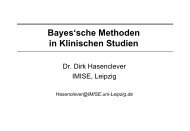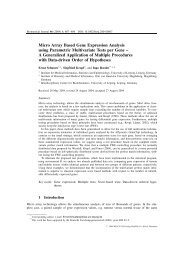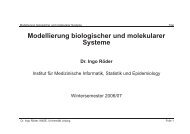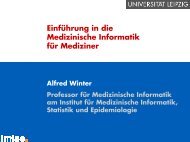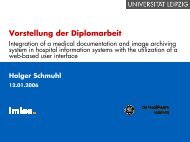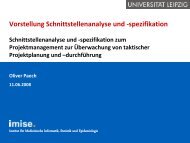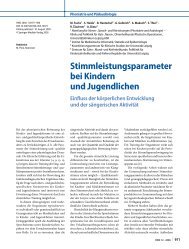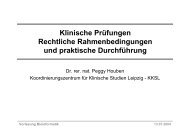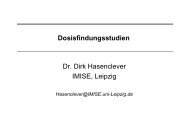Age-dependence of lipid parameters in the general population and ...
Age-dependence of lipid parameters in the general population and ...
Age-dependence of lipid parameters in the general population and ...
You also want an ePaper? Increase the reach of your titles
YUMPU automatically turns print PDFs into web optimized ePapers that Google loves.
Z Gerontol Geriat 37:207–213 (2004)<br />
DOI 10.1007/s00391-004-0232-3<br />
CONTRIBUTION TO THE MAIN TOPIC<br />
V. Richter<br />
F. Rassoul<br />
B. Hentschel<br />
K. Ko<strong>the</strong><br />
M. Krobara<br />
R. Unger<br />
K. Purschwitz<br />
W. Rotzsch<br />
J. Thiery<br />
K. Muradian<br />
<strong>Age</strong>-<strong>dependence</strong> <strong>of</strong> <strong>lipid</strong> <strong>parameters</strong><br />
<strong>in</strong> <strong>the</strong> <strong>general</strong> <strong>population</strong> <strong>and</strong> vegetarians<br />
Received: 7 April 2004<br />
Accepted: 13 April 2004<br />
Pr<strong>of</strong>. Dr. Volker Richter ())<br />
Priv.-Doz. Dr. Fausi Rassoul<br />
Kerst<strong>in</strong> Ko<strong>the</strong> · Manuela Krobara<br />
Renate Unger · Dipl.-Biotechnol. Kathr<strong>in</strong><br />
Purschwitz · Pr<strong>of</strong>. Dr. Wolfgang Rotzsch<br />
Pr<strong>of</strong>. Dr. Joachim Thiery<br />
Institut für Laboratoriumsmediz<strong>in</strong><br />
Kl<strong>in</strong>ische Chemie und Molekulare<br />
Diagnostik<br />
Universitätskl<strong>in</strong>ikum Leipzig<br />
Liebigstraße 27<br />
04103 Leipzig, Germany<br />
Arbeitsgeme<strong>in</strong>schaft für Gesundheitsförderung<br />
und Arterioskleroseprävention<br />
(AGA) e.V./Germany<br />
Dipl.-Math. Bett<strong>in</strong>a Hentschel<br />
Institut für Mediz<strong>in</strong>ische Informatik<br />
Statistik und Epidemiologie<br />
Universität Leipzig<br />
Liebigstraße 27<br />
04103 Leipzig, Germany<br />
Dr. Khachik Muradian<br />
Institute <strong>of</strong> Gerontology<br />
Academy <strong>of</strong> Medical Sciences<br />
Vyshgorodskaya street 67<br />
04114 Kiev/Ukra<strong>in</strong>e<br />
Altersabhängigkeit von Lipidparametern<br />
<strong>in</strong> der Allgeme<strong>in</strong>bevölkerung<br />
und bei Vegetariern<br />
n Summary <strong>Age</strong>-dependent<br />
changes <strong>of</strong> <strong>lipid</strong> metabolism may<br />
arise both as a result <strong>of</strong> mechanisms<br />
<strong>of</strong> biological age<strong>in</strong>g <strong>and</strong><br />
factors <strong>in</strong>fluenc<strong>in</strong>g age-dependent<br />
changes. To study possible <strong>in</strong>fluences<br />
<strong>of</strong> nutrition <strong>and</strong> life-style <strong>of</strong><br />
vegetarians on age-<strong>dependence</strong> <strong>of</strong><br />
<strong>lipid</strong> <strong>parameters</strong>, subjects <strong>of</strong> <strong>general</strong><br />
<strong>population</strong> were compared<br />
with vegetarians. In <strong>the</strong> frame <strong>of</strong><br />
<strong>population</strong>-based <strong>lipid</strong> screen<strong>in</strong>g<br />
projects <strong>in</strong> <strong>the</strong> city <strong>of</strong> Leipzig/<br />
Germany (Lipid Study Leipzig,<br />
LSL) 10 550 subjects (3 816 men<br />
<strong>and</strong> 6 734 women, age 18–99 years)<br />
<strong>of</strong> <strong>general</strong> <strong>population</strong> were compared<br />
with 417 vegetarians<br />
(vegans, lacto-vegetarians, lactoovo-vegetarians,<br />
148 men <strong>and</strong> 269<br />
women, age 18–93 years). Most <strong>of</strong><br />
<strong>the</strong> vegetarians <strong>in</strong>cluded <strong>in</strong> <strong>the</strong><br />
study were members <strong>of</strong> <strong>the</strong> German<br />
Society <strong>of</strong> Vegetarians. The<br />
study program <strong>in</strong>cluded capillary<br />
blood cholesterol measurements<br />
<strong>and</strong> <strong>the</strong> determ<strong>in</strong>ation <strong>of</strong> highdensity<br />
lipoprote<strong>in</strong> (HDL)-cholesterol,<br />
<strong>the</strong> measurement <strong>of</strong> o<strong>the</strong>r<br />
cardiovascular risk factors <strong>and</strong> <strong>the</strong><br />
evaluation <strong>of</strong> dietary <strong>and</strong> life-style<br />
factors. Evaluation <strong>of</strong> cardiovascular<br />
risk pr<strong>of</strong>ile with<strong>in</strong> LSL was<br />
connected with <strong>in</strong>dividual consultation.<br />
The mean total cholesterol <strong>and</strong><br />
non-HDL-cholesterol level <strong>and</strong> <strong>the</strong><br />
total: HDL-cholesterol ratio<br />
showed <strong>the</strong> expected age-<strong>dependence</strong>,<br />
with maximum values<br />
with<strong>in</strong> <strong>the</strong> decade 60–70 years.<br />
Vegetarians showed lower total<br />
<strong>and</strong> non-HDL-cholesterol levels <strong>in</strong><br />
comparison with <strong>the</strong> <strong>general</strong> <strong>population</strong>.<br />
Fur<strong>the</strong>rmore, <strong>the</strong> age-dependent<br />
<strong>in</strong>crease <strong>of</strong> <strong>the</strong>se <strong>parameters</strong><br />
is less pronounced under <strong>the</strong><br />
conditions <strong>of</strong> vegetarian nutrition<br />
<strong>and</strong> life-style. Especially <strong>in</strong> young<br />
adulthood a significant difference<br />
is observed. Thus, <strong>the</strong> results <strong>of</strong><br />
<strong>the</strong> present study reveal <strong>the</strong> role <strong>of</strong><br />
nutritional <strong>and</strong> life-style factors<br />
that determ<strong>in</strong>e <strong>the</strong> <strong>lipid</strong> pr<strong>of</strong>ile on<br />
a <strong>population</strong> basis <strong>and</strong> suggest that<br />
<strong>the</strong> known age-dependent rise <strong>of</strong><br />
<strong>the</strong> level <strong>of</strong> a<strong>the</strong>rogenic plasma lipoprote<strong>in</strong>s<br />
is partly preventable.<br />
n Key words <strong>Age</strong><strong>in</strong>g –<br />
lipoprote<strong>in</strong>s – cholesterol –<br />
<strong>general</strong> <strong>population</strong> – vegetarians<br />
n Zusammenfassung Altersabhängige<br />
Veränderungen im Lipidst<strong>of</strong>fwechsel<br />
können sowohl auf<br />
Mechanismen des biologischen<br />
Alterns zurückzuführen se<strong>in</strong> als<br />
auch auf Faktoren, welche diese<br />
bee<strong>in</strong>flussen. Um mögliche Effekte<br />
der Ernährung und des Lebensstils<br />
von Vegetariern auf die<br />
Altersabhängigkeit von Lipidparametern<br />
zu untersuchen, wurden<br />
ZGG 232
208 Zeitschrift für Gerontologie und Geriatrie, B<strong>and</strong> 37, Heft 3 (2004)<br />
© Ste<strong>in</strong>kopff Verlag 2004<br />
Personen der Allgeme<strong>in</strong>bevölkerung<br />
mit Vegetariern verglichen.<br />
Im Rahmen von Lipidscreen<strong>in</strong>g-<br />
Projekten auf Bevölkerungsebene<br />
<strong>in</strong> Leipzig (Lipid-Studie Leipzig,<br />
LSL) erfolgte der Vergleich von<br />
10 550 Personen (3 816 Männer<br />
und 6734 Frauen im Alter von<br />
18–99 Jahren) der Allgeme<strong>in</strong>bevölkerung<br />
mit 417 Vegetariern<br />
(Veganer, Lacto-Vegetarier, Lactoovo-Vegetarier,<br />
148 Männer und<br />
269 Frauen im Alter von 18–93<br />
Jahren). Die <strong>in</strong> die Untersuchungen<br />
e<strong>in</strong>bezogenen Vegetarier waren<br />
weitgehend Mitglieder des<br />
Deutschen Vegetarierbundes. Das<br />
Untersuchungsprogramm schloss<br />
die Cholesterolmessung aus Kapillarblut<br />
und die Bestimmung<br />
von High-density-Lipoprote<strong>in</strong><br />
(HDL)-Cholesterol sowie die Messung<br />
weiterer kardiovaskulärer<br />
Risik<strong>of</strong>aktoren und die Evaluation<br />
von Ernährungs- und Lebensstilfaktoren<br />
sowie e<strong>in</strong>e <strong>in</strong>dividuelle<br />
Beratung e<strong>in</strong>.<br />
Die mittleren Spiegel von Gesamtcholesterol<br />
und Nicht-HDL-<br />
Cholesterol sowie die Relationen<br />
Gesamtcholesterol/HDL-Cholesterol<br />
zeigten die erwartete Altersabhängigkeit<br />
mit Maxima <strong>in</strong> der Altersdekade<br />
60–70 Jahre. Vegetarier<br />
wiesen im Vergleich zur Allgeme<strong>in</strong>bevölkerung<br />
niedrigere Konzentrationen<br />
an Cholesterol und<br />
Nicht-HDL-Cholesterol auf. Weiterh<strong>in</strong><br />
ist der altersabhängige Anstieg<br />
dieser Parameter unter den<br />
Bed<strong>in</strong>gungen der vegetarischen<br />
Ernährungs- und Lebensweise<br />
weniger ausgeprägt. E<strong>in</strong> signifikanter<br />
Unterschied besteht <strong>in</strong>sbesondere<br />
bei jungen Erwachsenen.<br />
Der bei Vegetariern e<strong>in</strong>geschränkte<br />
altersabhängige Anstieg<br />
der für das a<strong>the</strong>rogene Risiko relevanten<br />
Lipidparameter weist auf<br />
die determ<strong>in</strong>ierende Wirkung<br />
exogener Faktoren der Ernährungs-<br />
und Lebensweise zusätzlich<br />
zu den für die Altersabhängigkeit<br />
angenommenen endogenen<br />
Ursachen h<strong>in</strong>. Somit ist die<br />
altersabhängige Cholesterol-Erhöhung<br />
präventiv zu bee<strong>in</strong>flussen.<br />
n Schlüsselwörter Altern –<br />
Lipoprote<strong>in</strong>e – Cholesterol –<br />
Allgeme<strong>in</strong>bevölkerung –<br />
Vegetarier<br />
Introduction<br />
Advanc<strong>in</strong>g age is a risk factor for a<strong>the</strong>rosclerotic cardiovascular<br />
disease (CVD). This is due <strong>in</strong> large part<br />
to <strong>the</strong> cumulative damage <strong>of</strong> o<strong>the</strong>r cardiovascular<br />
risk factors on <strong>the</strong> arterial tree. Many <strong>of</strong> <strong>the</strong> contribut<strong>in</strong>g<br />
factors are related closely to life-style <strong>in</strong>clud<strong>in</strong>g<br />
a<strong>the</strong>rogenic diets, sedentary life habits, overweight,<br />
<strong>and</strong> cigarette smok<strong>in</strong>g. Never<strong>the</strong>less a grow<strong>in</strong>g<br />
body <strong>of</strong> evidence <strong>in</strong>dicates that major vascular<br />
events can be reduced by risk factor management <strong>in</strong><br />
older subjects. Fur<strong>the</strong>rmore, results <strong>of</strong> cl<strong>in</strong>ical trials<br />
have shown that <strong>lipid</strong> lower<strong>in</strong>g <strong>the</strong>rapy reduced coronary<br />
heart disease <strong>in</strong> elderly <strong>in</strong>dividuals [19]. It is<br />
well recognized that a favourable lipoprote<strong>in</strong> pr<strong>of</strong>ile<br />
provides protection from a<strong>the</strong>rosclerotic CVD. Cholesterol<br />
represents a primary cardiovascular risk factor.<br />
In <strong>general</strong>, serum cholesterol levels <strong>in</strong>crease up<br />
to <strong>the</strong> age <strong>of</strong> 60–70 years <strong>in</strong> both men <strong>and</strong> women<br />
due to <strong>in</strong>creases <strong>in</strong> low-density lipoprote<strong>in</strong> (LDL)-<br />
cholesterol. This age-dependent change is characteristic<br />
<strong>of</strong> elderly <strong>population</strong>s <strong>and</strong> has been observed <strong>in</strong><br />
all epidemiologic cross-sectional studies [4, 11, 18].<br />
However, reliable data on <strong>the</strong> longitud<strong>in</strong>al <strong>in</strong>crease<br />
<strong>of</strong> <strong>lipid</strong> <strong>parameters</strong> with age are rare [2, 8, 22].<br />
Fur<strong>the</strong>rmore, data with respect to <strong>the</strong> underly<strong>in</strong>g<br />
causes <strong>of</strong> <strong>the</strong> age-<strong>dependence</strong> are scarce. Dietary<br />
<strong>and</strong> life-style factors may <strong>in</strong>fluence <strong>the</strong> age-<strong>dependence</strong><br />
<strong>of</strong> <strong>lipid</strong> <strong>parameters</strong>.<br />
Although no s<strong>in</strong>gle dietary factor is universally<br />
associated with CVD, high caloric diets rich <strong>in</strong> saturated<br />
fatty acids are <strong>general</strong>ly positively correlated<br />
with hypercholesterolemia <strong>and</strong> coronary artery disease.<br />
A diet consist<strong>in</strong>g largely <strong>of</strong> low-caloric vegetables<br />
<strong>and</strong> fruit markedly reduces risk factors for<br />
a<strong>the</strong>rosclerosis. Epidemiological studies have shown<br />
a decreased risk for CVD among vegetarians [9].<br />
Fur<strong>the</strong>rmore, data from prospective studies raise <strong>the</strong><br />
possibility that <strong>the</strong> life-style pattern that <strong>in</strong>cludes a<br />
very low meat <strong>in</strong>take is associated with greater longevity<br />
[20]. Vegetarians <strong>and</strong> <strong>general</strong> <strong>population</strong> differ<br />
both with respect to nutrition <strong>and</strong> o<strong>the</strong>r life-style<br />
factors. These factors may have implications for lipoprote<strong>in</strong><br />
metabolism [10, 12]. Studies on <strong>population</strong><br />
basis among residents <strong>of</strong> Leipzig/Germany showed<br />
significant differences <strong>in</strong> total cholesterol, ratios <strong>of</strong><br />
cholesterol:high-density lipoprote<strong>in</strong> (HDL)-cholesterol,<br />
mean body-mass-<strong>in</strong>dex <strong>and</strong> various life-style<br />
factors between <strong>the</strong> <strong>general</strong> <strong>population</strong> <strong>and</strong> vegetarians<br />
[13].<br />
Both animal experiments <strong>and</strong> cl<strong>in</strong>ical trials, as well<br />
as cross-sectional <strong>and</strong> longitud<strong>in</strong>al studies have<br />
shown age-associated changes <strong>in</strong> lipoprote<strong>in</strong> metabolism<br />
[11]. These age-dependent changes may arise<br />
both as a result <strong>of</strong> <strong>in</strong>tr<strong>in</strong>sic mechanisms <strong>of</strong> biological<br />
age<strong>in</strong>g <strong>and</strong> environmental factors <strong>in</strong>fluenc<strong>in</strong>g age-dependent<br />
changes <strong>in</strong>clud<strong>in</strong>g dietary habits. To clarify<br />
possible <strong>in</strong>fluences <strong>of</strong> nutrition <strong>and</strong> life-style <strong>of</strong> vegetarians<br />
on age-<strong>dependence</strong> <strong>of</strong> <strong>lipid</strong> <strong>parameters</strong>, <strong>in</strong> <strong>the</strong>
V. Richter et al.<br />
<strong>Age</strong><strong>in</strong>g, lipoprote<strong>in</strong>s <strong>and</strong> vegetarian nutrition<br />
209<br />
frame <strong>of</strong> Leipzig <strong>lipid</strong> screen<strong>in</strong>g projects <strong>the</strong> <strong>general</strong><br />
<strong>population</strong> was compared with vegetarians.<br />
naire. Risk evaluation was connected with <strong>in</strong>dividual<br />
consultation.<br />
Study design <strong>and</strong> measurements<br />
n Subjects<br />
With <strong>the</strong> aim <strong>of</strong> evaluat<strong>in</strong>g <strong>the</strong> <strong>lipid</strong> <strong>and</strong> risk factor<br />
pr<strong>of</strong>ile on a <strong>population</strong> basis a cross-sectional study<br />
(Lipid Study Leipzig – LSL) was <strong>in</strong>itiated <strong>in</strong> <strong>the</strong> city<br />
<strong>of</strong> Leipzig, Germany. LSL was carried out at community<br />
centres, work sites <strong>and</strong> at <strong>the</strong> University. To<br />
study <strong>the</strong> possible <strong>in</strong>fluence <strong>of</strong> nutrition <strong>and</strong> lifestyle<br />
<strong>of</strong> vegetarians on age-<strong>dependence</strong> <strong>of</strong> <strong>lipid</strong> <strong>parameters</strong>,<br />
10 550 subjects (3 816 men <strong>and</strong> 6 734 women,<br />
age 18–99 years) <strong>of</strong> <strong>the</strong> <strong>general</strong> <strong>population</strong> were<br />
compared with 417 vegetarians (vegans, lacto-vegetarians,<br />
lacto-ovo-vegetarians, 148 men <strong>and</strong> 269<br />
women, age 18–93 years). Recruitment <strong>of</strong> vegetarians<br />
was carried out ma<strong>in</strong>ly dur<strong>in</strong>g meet<strong>in</strong>gs <strong>of</strong> <strong>the</strong> German<br />
Society <strong>of</strong> Vegetarians (Deutscher Vegetarierbund<br />
e.V.).<br />
n Study program<br />
The study program <strong>in</strong>cluded capillary blood cholesterol<br />
measurements <strong>and</strong> <strong>the</strong> determ<strong>in</strong>ation <strong>of</strong> HDLcholesterol<br />
us<strong>in</strong>g <strong>the</strong> dry-chemistry Reflotron Systems<br />
(Roche Diagnostics GmbH, Mannheim). The<br />
subjects were compared with respect to <strong>the</strong> follow<strong>in</strong>g<br />
<strong>parameters</strong>:<br />
n Total cholesterol, which reflects <strong>the</strong> sum <strong>of</strong> cholesterol<br />
carried by all <strong>of</strong> <strong>the</strong> lipoprote<strong>in</strong> subspecies<br />
<strong>and</strong> ratio <strong>of</strong> total cholesterol to HDL-cholesterol<br />
(Cholesterol carried by vasoprotective HDL<br />
particles).<br />
n Non-HDL-cholesterol [1, 6], difference between<br />
total <strong>and</strong> HDL-cholesterol, which reflects <strong>the</strong><br />
sum <strong>of</strong> cholesterol carried by all <strong>of</strong> <strong>the</strong> potentially<br />
a<strong>the</strong>rogenic lipoprote<strong>in</strong> subspecies (lowdensity<br />
lipoprote<strong>in</strong>s, very-low-density lipoprote<strong>in</strong>s).<br />
Fur<strong>the</strong>rmore, <strong>the</strong> study program <strong>in</strong>cluded measurement<br />
<strong>of</strong> weight <strong>and</strong> height (body-mass-<strong>in</strong>dex), waist<br />
<strong>and</strong> hip circumfance (waist-to-hip ratio), <strong>and</strong> blood<br />
pressure. The participants were questioned on <strong>the</strong>ir<br />
own <strong>and</strong> <strong>the</strong>ir family history regard<strong>in</strong>g cardiovascular<br />
diseases, risk factors, <strong>and</strong> metabolic disorders.<br />
Fur<strong>the</strong>rmore, life-style <strong>and</strong> dietary factors (smok<strong>in</strong>g<br />
behaviour, physical activity <strong>and</strong> dietary habits) were<br />
evaluated. The exam<strong>in</strong>ations <strong>in</strong>cluded an <strong>in</strong>terview<br />
<strong>and</strong> a health habits <strong>and</strong> food frequency question-<br />
n Statistics<br />
The association between age <strong>and</strong> total cholesterol as<br />
well as age <strong>and</strong> non-HDL-cholesterol were evaluated<br />
us<strong>in</strong>g regression analyses for male <strong>and</strong> female subjects,<br />
respectively. L<strong>in</strong>ear regression models were<br />
performed for three age groups separately. To analyse<br />
<strong>the</strong> impact <strong>of</strong> nutrition (vegetarians vs. <strong>general</strong><br />
<strong>population</strong>), an <strong>in</strong>dicator variable <strong>and</strong> an <strong>in</strong>teraction<br />
term were <strong>in</strong>cluded <strong>in</strong> <strong>the</strong> models. Slopes with 95%<br />
confidential <strong>in</strong>terval were presented.<br />
The v 2 test was used to test statistical significance<br />
<strong>in</strong> <strong>the</strong> prevalence values. Differences were considered<br />
statistically significant at p
210 Zeitschrift für Gerontologie und Geriatrie, B<strong>and</strong> 37, Heft 3 (2004)<br />
© Ste<strong>in</strong>kopff Verlag 2004<br />
Fig. 1 Total cholesterol levels <strong>of</strong> <strong>the</strong><br />
<strong>general</strong> <strong>population</strong> (—, n =10550;<br />
3816 men, 6734 women) <strong>and</strong> vegetarians<br />
(****, n =417; 148 men, 269<br />
women) with respect to age<br />
Fig. 2 Non-HDL-cholesterol levels <strong>of</strong><br />
<strong>the</strong> <strong>general</strong> <strong>population</strong> (—, n=10 550;<br />
3816 men, 6734 women) <strong>and</strong> vegetarians<br />
(**** , n =417; 148 men,<br />
269 women) with respect to age<br />
cant difference between <strong>the</strong> slopes was found. Regression<br />
coefficients were lower <strong>in</strong> vegetarians <strong>in</strong><br />
comparison with <strong>the</strong> <strong>general</strong> <strong>population</strong>. In higher<br />
age groups no statistically significant difference between<br />
<strong>the</strong> <strong>general</strong> <strong>population</strong> <strong>and</strong> vegetarians regard<strong>in</strong>g<br />
<strong>the</strong> age-dependent change <strong>of</strong> <strong>lipid</strong> <strong>parameters</strong><br />
was observed (Table 1).<br />
A decreased prevalence <strong>of</strong> <strong>the</strong> prognostic favourable<br />
non-HDL-cholesterol class < 3.9 mmol/l is seen<br />
with respect to age. Interest<strong>in</strong>gly, higher percentages<br />
<strong>of</strong> this non-HDL-cholesterol class were found <strong>in</strong> elderly<br />
vegetarians <strong>in</strong> comparison with subjects <strong>of</strong> <strong>the</strong><br />
<strong>general</strong> <strong>population</strong> (Fig. 3).<br />
Discussion<br />
Certa<strong>in</strong> fundamental <strong>parameters</strong> <strong>of</strong> age<strong>in</strong>g such as<br />
life-span <strong>and</strong> several age-related diseases can be<br />
modified by diet [16]. Vegetarian diets have been associated<br />
with low rates <strong>of</strong> CVD <strong>and</strong> mortality [9]. It<br />
may be difficult to determ<strong>in</strong>e which <strong>of</strong> <strong>the</strong> many<br />
changes <strong>of</strong> age<strong>in</strong>g are <strong>in</strong>nate or genetically determ<strong>in</strong>ed<br />
ra<strong>the</strong>r than <strong>the</strong> result <strong>of</strong> permanent environmental<br />
factors such as nutrition. To study possible<br />
<strong>in</strong>fluences <strong>of</strong> nutrition <strong>and</strong> life-style <strong>of</strong> vegetarians<br />
on age-<strong>dependence</strong> <strong>of</strong> <strong>lipid</strong> <strong>parameters</strong>, subjects <strong>of</strong><br />
<strong>the</strong> <strong>general</strong> <strong>population</strong> were compared with vegetarians.<br />
An elevation <strong>of</strong> <strong>the</strong> plasma concentration <strong>of</strong><br />
a<strong>the</strong>rogenic lipoprote<strong>in</strong>s <strong>and</strong> <strong>of</strong> <strong>the</strong> ratio a<strong>the</strong>rogenic<br />
lipoprote<strong>in</strong>s: vasoprotective lipoprote<strong>in</strong>s is a primary
V. Richter et al.<br />
<strong>Age</strong><strong>in</strong>g, lipoprote<strong>in</strong>s <strong>and</strong> vegetarian nutrition<br />
211<br />
Table 1 Regression coefficients with 95% confidential <strong>in</strong>tervals (CI); p-value: difference <strong>of</strong> <strong>the</strong> slopes between <strong>the</strong> <strong>general</strong> <strong>population</strong> <strong>and</strong> vegetarians, n number <strong>of</strong><br />
subjects <strong>of</strong> <strong>general</strong> <strong>population</strong> <strong>and</strong> vegetarians respectively<br />
Parameter Sex <strong>Age</strong> General <strong>population</strong><br />
[95% CI]<br />
Vegetarian<br />
[95% CI]<br />
p-values<br />
Cholesterol male 18–30 years 3.7 –1.8 0.030<br />
(n =456/32) [2.4; 5.0] [–6.6; 3.0]<br />
31–50 years 1.9 2.2 0.814<br />
(n =568/38) [1.3; 2.5] [0.2; 4.2]<br />
51–70 years 0.3 0.4 0.886<br />
(n =2102/54) [–0.1; 0.6] [–1.8; 2.6]<br />
female 18–30 years 2.1 –0.9 0.036<br />
(n =594/93) [1.1; 3.1] [–3.7; 1.8]<br />
31–50 years 1.9 0.7 0.209<br />
(n =1079/61) [1.5; 2.3] [–0.9; 2.3]<br />
51–70 years 1.2 0.3 0.278<br />
(n =3728/91) [1.0: 1.5] [–1.6; 2.1]<br />
Non-HDL-cholesterol male 18–30 years 3.5 –0.9 0.095<br />
(n =455/30) [2.1; 4.8] [–5.4; 3.6]<br />
31–50 years 1.9 1.5 0.798<br />
(n =566/36) [1.2; 2.6] [–0.6; 3.7]<br />
51–70 yeras 0.2 0.6 0.764<br />
(n =2100/52) [–0.1; 0.6] [–1.5; 2.6]<br />
female 18–30 years 1.8 0.4 0.317<br />
(n =593/92) [0.8; 2.8] [–2.1; 2.9]<br />
31–50 years 1.8 0.9 0.361<br />
(n =1077/60) [1.3; 2.2] [–0.7; 2.5]<br />
51–70 years 1.5 0.2 0.177<br />
(n =3728/91) [1.2; 1.7] [–1.8; 2.1]<br />
Fig. 3 Prevalence <strong>of</strong> <strong>the</strong> non-HDL-cholesterol<br />
class
212 Zeitschrift für Gerontologie und Geriatrie, B<strong>and</strong> 37, Heft 3 (2004)<br />
© Ste<strong>in</strong>kopff Verlag 2004<br />
duced lipoprote<strong>in</strong> lipase activity <strong>and</strong> delayed clearance<br />
<strong>of</strong> triglyceride-rich lipoprote<strong>in</strong>s [11]. LDL receptor<br />
activity plays an important role <strong>in</strong> regulat<strong>in</strong>g LDL<br />
metabolism. There is a decrease <strong>in</strong> <strong>the</strong> fractional rate<br />
<strong>of</strong> catabolism <strong>of</strong> LDL with <strong>in</strong>creas<strong>in</strong>g age which may<br />
be associated with a dim<strong>in</strong>ished LDL receptor activity<br />
[7]. However, it was proposed that <strong>the</strong> apparent decl<strong>in</strong>e<br />
<strong>in</strong> LDL receptor activity noted with age is actually<br />
related to dietary factors. A high fat consumption<br />
suppresses LDL receptor activity [3]. Based on <strong>the</strong>se<br />
observations, it should be evident that a low total fat<br />
diet accord<strong>in</strong>g to <strong>the</strong> eat<strong>in</strong>g pattern <strong>of</strong> vegetarians<br />
would be helpful <strong>in</strong> reduc<strong>in</strong>g <strong>the</strong> age-dependent <strong>in</strong>crease<br />
<strong>of</strong> a<strong>the</strong>rogenic lipoprote<strong>in</strong>s.<br />
In <strong>the</strong> present study both <strong>in</strong> <strong>the</strong> <strong>general</strong> <strong>population</strong><br />
<strong>and</strong> vegetarians an age-dependent <strong>in</strong>crease <strong>of</strong><br />
a<strong>the</strong>rogenic lipoprote<strong>in</strong>s has been found. However,<br />
<strong>the</strong> age-<strong>dependence</strong> <strong>of</strong> total cholesterol, non-HDLcholesterol,<br />
<strong>and</strong> <strong>the</strong> ratio cholesterol:HDL-cholesterol<br />
is less pronounced under <strong>the</strong> conditions <strong>of</strong> a vegetarian<br />
nutrition <strong>and</strong> life-style. Especially <strong>in</strong> young<br />
adulthood a significant difference between <strong>the</strong> slopes<br />
<strong>of</strong> subjects <strong>of</strong> <strong>general</strong> <strong>population</strong> <strong>and</strong> vegetarians is<br />
observed. Thus, <strong>the</strong> results suggest that <strong>the</strong> age-<strong>dependence</strong><br />
<strong>of</strong> lipoprote<strong>in</strong> <strong>parameters</strong> may arise both<br />
as a consequence <strong>of</strong> <strong>in</strong>tr<strong>in</strong>sic mechanisms <strong>and</strong> environmental<br />
factors. The less pronounced age-<strong>dependence</strong><br />
<strong>of</strong> plasma <strong>lipid</strong>s <strong>of</strong> vegetarians is <strong>in</strong> agreement<br />
with o<strong>the</strong>r epidemiological studies <strong>in</strong> <strong>population</strong>s<br />
with low <strong>in</strong>takes <strong>of</strong> saturated fat <strong>and</strong> cholesterol <strong>and</strong><br />
with a high degree <strong>in</strong> physical activity. In Ethiopia,<br />
an age-<strong>dependence</strong> <strong>of</strong> total <strong>and</strong> LDL-cholesterol was<br />
seen. However, <strong>in</strong> comparison with <strong>in</strong>dustrialized<br />
countries lower <strong>lipid</strong> levels were found <strong>in</strong> all age<br />
groups. Fur<strong>the</strong>rmore, <strong>in</strong> Ethiopia higher <strong>lipid</strong> values<br />
were found <strong>in</strong> blood serum <strong>of</strong> urban persons <strong>in</strong><br />
comparison with rural subjects, which may be a reflection<br />
<strong>of</strong> different life-styles [17]. In summary, <strong>the</strong><br />
results <strong>of</strong> <strong>the</strong> present study reveal <strong>the</strong> primary role<br />
<strong>of</strong> nutritional <strong>and</strong> life-style factors that determ<strong>in</strong>e<br />
<strong>the</strong> <strong>lipid</strong> pr<strong>of</strong>ile on <strong>population</strong> basis <strong>and</strong> suggest that<br />
<strong>the</strong> known age-dependent rise <strong>of</strong> a<strong>the</strong>rogenetic plasma<br />
lipoprote<strong>in</strong>s is partly preventable.<br />
n Acknowledgement This research work was partially supported<br />
by <strong>the</strong> EDEN-Stiftung Bad Soden/Ts., Germany.<br />
References<br />
1. Athyros VG, Papageorgiou AA, Symeonidis<br />
AN, Elisaf M (2003) Nonhigh<br />
density lipoprote<strong>in</strong> cholesterol<br />
<strong>and</strong> coronary events dur<strong>in</strong>g longterm<br />
stat<strong>in</strong> <strong>the</strong>rapy. A<strong>the</strong>rosclerosis<br />
168:397–398<br />
2. Berns MAM, De Vries JHM, Katan<br />
MB (1988) Determ<strong>in</strong>ants <strong>of</strong> <strong>the</strong> <strong>in</strong>crease<br />
<strong>of</strong> serum cholesterol with age:<br />
A longitud<strong>in</strong>al study. Int J Epidemiol<br />
17:789–796<br />
3. Bilheimer DW (1991) Cl<strong>in</strong>ical considerations<br />
regard<strong>in</strong>g treatment <strong>of</strong> hypercholesterolemia<br />
<strong>in</strong> <strong>the</strong> elderly.<br />
A<strong>the</strong>rosclerosis 91:S 35–S 57<br />
4. Bruckert E (1999) Prevention <strong>of</strong> cardiovascular<br />
events <strong>in</strong> elderly hypercholesterolemic<br />
patients. Curr A<strong>the</strong>rosclerosis<br />
Rep 1:9–15<br />
5. Corti MC, Barbato GM, Baggio G<br />
(1997) Lipoprote<strong>in</strong> alternations <strong>and</strong><br />
a<strong>the</strong>rosclerosis <strong>in</strong> <strong>the</strong> elderly. Curr<br />
Op<strong>in</strong> Lipidol 8:236–241<br />
6. Grundy SM (2002) Low-density lipoprote<strong>in</strong>,<br />
non-high-density lipoprote<strong>in</strong>,<br />
<strong>and</strong> apolipoprote<strong>in</strong> B as targets <strong>of</strong><br />
<strong>lipid</strong>-lower<strong>in</strong>g <strong>the</strong>rapy. Circulation<br />
106:2526–2529<br />
7. Grundy SM, Vega GL, Bilheimer DW<br />
(1985) K<strong>in</strong>etic mechanisms determ<strong>in</strong><strong>in</strong>g<br />
variability <strong>in</strong> low density lipoprote<strong>in</strong><br />
levels <strong>and</strong> rise with age. Arteriosclerosis<br />
5:623–629<br />
8. Hershcopf RJ, Elahi D, Andres R,<br />
Baldw<strong>in</strong> HL, Raizes GS, Schocken<br />
DD, Tob<strong>in</strong> JD (1982) Longitud<strong>in</strong>al<br />
changes <strong>in</strong> serum cholesterol <strong>in</strong><br />
ma<strong>in</strong>: an epidemiologic search for an<br />
etiology. J Chron Dis 35:101–114<br />
9. Hu FB (2003) Plant-based foods <strong>and</strong><br />
prevention <strong>of</strong> cardiovascular disease:<br />
an overview. Am J Cl<strong>in</strong> Nutr<br />
78(Suppl):S 544–S 551<br />
10. Rassoul F, Purschwitz K, Reuter W,<br />
Richter V (1999) Lipoprote<strong>in</strong>s <strong>and</strong><br />
o<strong>the</strong>r cardiovascular risk factors under<br />
<strong>the</strong> conditions <strong>of</strong> vegetarian nutrition.<br />
A<strong>the</strong>rosclerosis 147(Suppl 2):<br />
S30<br />
11. Richter V (2004) Molekulare Grundlagen<br />
altersspezifischer Erkrankungen<br />
des Herz-Kreislauf-Systems und der<br />
Arteriosklerose. In: Ganten D, Ruckpaul<br />
K, Ruiz-Torres A (Eds) Molekularmediz<strong>in</strong>ische<br />
Grundlagen von altersspezifischen<br />
Erkrankungen. Spr<strong>in</strong>ger,<br />
Berl<strong>in</strong> Heidelberg New York, pp<br />
371–401<br />
12. Richter V, Purschwitz K, Bohusch A,<br />
Seim H, Weisbrich C, Reuter W, Sorger<br />
D, Rassoul F (1999) Lipoprote<strong>in</strong>s<br />
<strong>and</strong> o<strong>the</strong>r cl<strong>in</strong>ical – chemistry <strong>parameters</strong><br />
under <strong>the</strong> conditions <strong>of</strong> lacto-ovo-vegetarian<br />
nutrition. Nutr Res<br />
19:545–554<br />
13. Richter V, Rassoul F, Purschwitz K,<br />
Hentschel B (1993) Lipidscreen<strong>in</strong>g<br />
auf Bevölkerungsebene und bei Vegetariern.<br />
Akt Ernähr-Med 18:286–290<br />
14. Richter V, Rassoul F, Opitz F, Purschwitz<br />
K, Rotzsch W (1993) Altersabhängigkeit<br />
von Lipidst<strong>of</strong>fwechsel-<br />
Parametern: Screen<strong>in</strong>g-Untersuchungen<br />
auf Bevölkerungsebene. Z Gerontol<br />
26:260–264<br />
15. Richter V, Rassoul F, Purschwitz K,<br />
Richter E, Michel M, Riedel S, Schre<strong>in</strong>icke<br />
G, Schwarz R, Jucker F, Wenzel<br />
K (2002) Lipid Study Leipzig (LSL):<br />
Evaluation <strong>of</strong> cardiovascular risk factor<br />
pr<strong>of</strong>ile on <strong>population</strong> basis.<br />
A<strong>the</strong>rosclerosis 3(Suppl 2):193<br />
16. Roth GS, Ingram DK, Lane MA<br />
(2001) Caloric restriction <strong>in</strong> primates<br />
<strong>and</strong> relevance to humans. Ann NY<br />
Acad Sci 928:305–315<br />
17. Schifferaw K, Richter V, Rassoul F,<br />
Rotzsch W, Kleber H-P (1989) Lipoprote<strong>in</strong><br />
levels <strong>of</strong> rural <strong>and</strong> urban persons<br />
<strong>of</strong> Ethiopia <strong>in</strong> <strong>dependence</strong> on<br />
age. Z Altersforsch 44:353–358<br />
18. Shepherd J (2001) Issues surround<strong>in</strong>g<br />
age: vascular disease <strong>in</strong> <strong>the</strong> elderly.<br />
Curr Op<strong>in</strong> Lipidol 12:601–609<br />
19. Shepherd J (2003) Prevent<strong>in</strong>g <strong>the</strong> next<br />
event <strong>in</strong> <strong>the</strong> elderly: <strong>the</strong> PROSPER perspective.<br />
A<strong>the</strong>rosclerosis (Suppl 4):17–<br />
22
V. Richter et al.<br />
<strong>Age</strong><strong>in</strong>g, lipoprote<strong>in</strong>s <strong>and</strong> vegetarian nutrition<br />
213<br />
20. S<strong>in</strong>gh PN, Sabaté J, Fraser GE (2003)<br />
Does low meat consumption <strong>in</strong>crease<br />
life expectancy <strong>in</strong> humans? Am J Cl<strong>in</strong><br />
Nutr 78(Suppl):526S–532S<br />
21. Wald NJ, Law MR (1995) Serum cholesterol<br />
<strong>and</strong> ischaemic heart disease.<br />
A<strong>the</strong>rosclerosis 118(Suppl):S 1–S 5<br />
22. Yamada M, Wong FL, Kodama K, Sasaki<br />
H, Shimaoka K, Yamakido M<br />
(1997) Longitud<strong>in</strong>al trends <strong>in</strong> total<br />
serum cholesterol levels <strong>in</strong> a Japanese<br />
cohort, 1958–1986. J Cl<strong>in</strong> Epidemiol<br />
50:425–434



